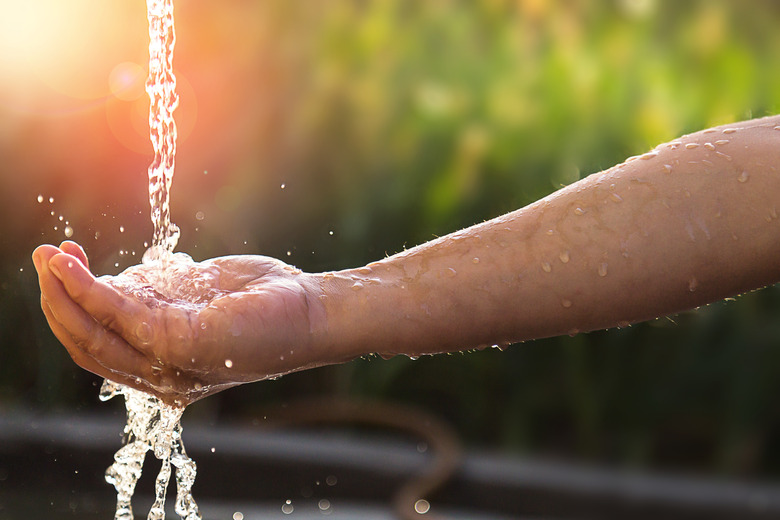What Are The 5 Emergent Properties Of Water?
Water appears to be the single most important environmental feature that allows the existence and maintenance of life. There are organisms that exist without sunlight or oxygen, but there have been none found as yet that exist completely independently of water. Even hardy cacti in the far reaches of the desert require some amount of water for survival. The secret to water's usefulness to life lies in its hydrogen-bonding characteristic, which confers five properties important to creating an environment where life can exist and thrive.
Water is Cohesive and Adhesive.
Water is Cohesive and Adhesive.
Water molecules are polar. That is, one end of the molecule is more electronegative (negative charge) than the other end (positive charge). Therefore, the opposite ends of different water molecules are attracted to each other like the opposite ends of magnets. The attractive forces between water molecules are known as "hydrogen bonds." The hydrogen bonding tendency of water causes it to be 'sticky,' in that water molecules tend to stick together (as in a puddle). This is known as cohesion. Because of this property, water has a high surface tension. This means that it takes a little extra force to break the surface of the water puddle. Water is also adhesive, meaning that it tends to stick to other molecules besides water. In particular it will stick to water soluble (hydrophilic) substances, such as starches or cellulose. It will not adhere to hydrophobic substances, such as oil.
Water Maintains a Relatively Constant Temperature.
Water Maintains a Relatively Constant Temperature.
Water has high specific heat, high heat of vaporization, and an evaporative cooling property that together causes it to tend to maintain a constant temperature. Water temperatures can change, of course, they just change more slowly than the temperatures of other substances. Each of these properties is due to the hydrogen bonding property of water. The breaking and forming of the bonds, which would be required to change the temperature of the water (temperature affects the speed of molecule movement), takes an extra amount of energy (or heat) to complete.
High specific heat means that water absorbs and retains heat better than many substances. That is, it takes more energy (heat) to change the temperature of water. High heat of vaporization means that it takes more energy (heat) to turn water into a gas (vapor) than many other substances. Evaporative cooling is a result of the water molecules that do escape into a gaseous state (into vapor) carrying heat with them, and therefore out of the water puddle. As a result, the water puddle will tend to not increase in temperature much, and remain constant.
Water Is a Good Solvent
Water Is a Good Solvent
Because water is polar and so readily hydrogen bonds, other polar molecules will readily dissolve in it. Remember that for polar molecules, there is a negative charge on one end of the molecule, which is attracted to the positive charge on the other end of other molecules, like a magnet. This attraction forms hydrogen bonds. Polar molecules are also known as hydrophilic (water-loving) or water-soluble molecules. However, water does not dissolve nonpolar or hydrophobic (water fearing) molecules well. Hydrophobic molecules include oils and fats.
Water Expands When It Freezes
Water Expands When It Freezes
The high number of hydrogen bonds that exist within liquid water cause the water molecules to be farther apart than the molecules may be in other liquids (the bonds take up space themselves). In liquid water, the bonds are constantly being formed, broken, and reformed, so that the water can flow without a specific form. However, when water freezes, the bonds can no longer be broken, because there is no heat energy to do so. Therefore, the water molecules form a lattice that is more expansive than water in liquid form. Because the frozen water contains the same number of molecules but is more expansive, it is less dense than liquid water. The less dense ice (solid water) will therefore float over the more dense liquid water.
A film of ice over a body of water acts as an insulator. As a result, the liquid water underneath the ice will be protected from the outside air and will be less likely to freeze as well. This is yet another reason that water is able to maintain a consistent temperature.
Water Has a Neutral pH.
Water Has a Neutral pH.
Water [H2O] can dissociate into hydrogen [H+] and hydroxyl [OH-] ions. pH is a relative measure of hydrogen to hydroxyl ions. Because water has a roughly equal number of hydrogen and hydroxyl ions, it is neither acidic nor basic, but has a neutral pH of 7. And, because it contains both hydrogen and hydroxyl ions, it can provide whichever may be needed to regulate the pH of an enzymatic reaction that occurs in its presence. As a result, it is a multipurpose solvent, within which millions of different enzymatic reactions with different pH requirements could potentially occur.
Cite This Article
MLA
Carney, Catherine. "What Are The 5 Emergent Properties Of Water?" sciencing.com, https://www.sciencing.com/5-emergent-properties-water-8622128/. 13 March 2018.
APA
Carney, Catherine. (2018, March 13). What Are The 5 Emergent Properties Of Water?. sciencing.com. Retrieved from https://www.sciencing.com/5-emergent-properties-water-8622128/
Chicago
Carney, Catherine. What Are The 5 Emergent Properties Of Water? last modified March 24, 2022. https://www.sciencing.com/5-emergent-properties-water-8622128/
